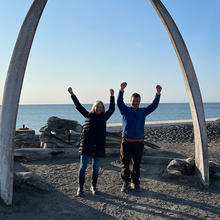- January 23, 2024
Mason scientists and partners will leverage their climate expertise and the university’s resources into broader societal implications, thanks to a $6 million grant from the National Science Foundation (NSF).
- August 23, 2023
The National Science Foundation's Navigating the New Arctic researchers traveled to a remote location to attend the Permafrost and Infrastructure Symposium in Utqiaġvik, Alaska, some 320 miles north of the Arctic Circle.
- November 16, 2021
Using virtual reality (VR) and artificial intelligence (AI), a team of researchers at George Mason University is taking a wrecking ball to barriers faced by neurodiverse individuals in construction.
- November 11, 2021
The National Science Foundation (NSF)’s I-Corps program is an accelerator that helps entrepreneurs and researchers work together “to bring invention to impact.” Mason serves as an official I-Corps site, supporting local grantees through the exploratory stages of venture-building, as well as preparing them to apply for the national-level program.
- Fri, 07/24/2020 - 05:00
Since the start of the coronavirus pandemic, the National Science Foundation has awarded more than 800 Rapid Response Research (RAPID) grants designed to get researchers into the field and lab quicker than the traditional grant process.
- Sat, 02/22/2020 - 09:08
The Arctic is warming at more than twice the rate of the rest of the planet, but for a team of researchers at George Mason University that’s just the tip of the iceberg of the changes to come.
- Fri, 10/18/2019 - 05:00
New trade routes in the Arctic mean unprecedented traffic and industrialization are likely to follow, so George Mason University’s Elise Miller-Hooks and her team of scientists will be taking a closer look at what that will mean for the region’s infrastructure and governance thanks to a $3 million National Science Foundation grant for a project called “An Expanding Global Maritime Network, Its Arctic Impacts and Reverberations.”






